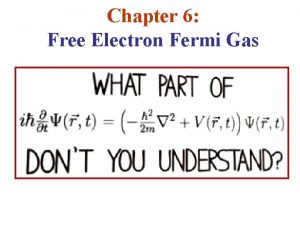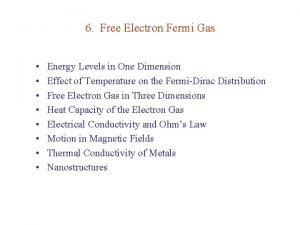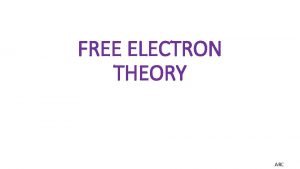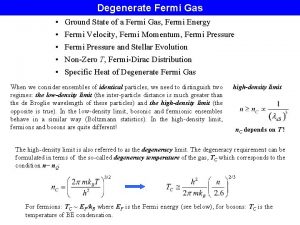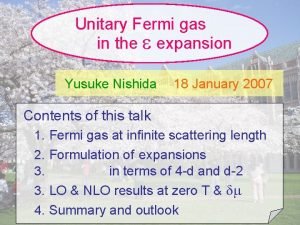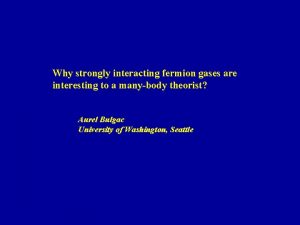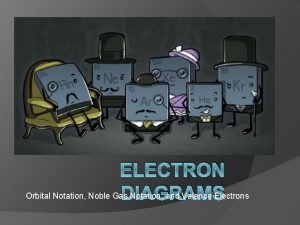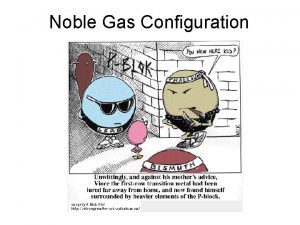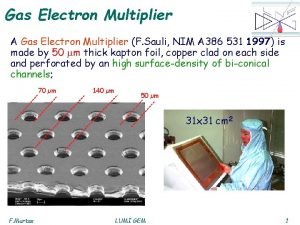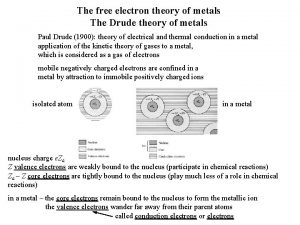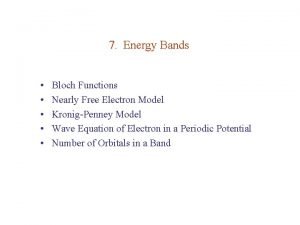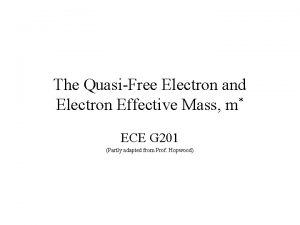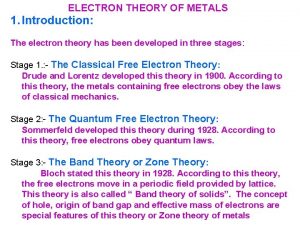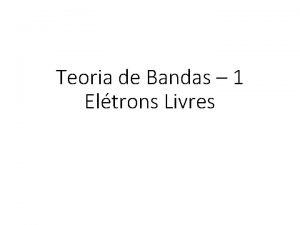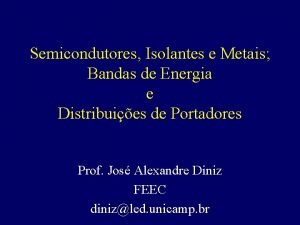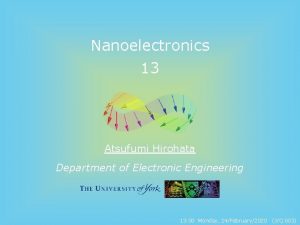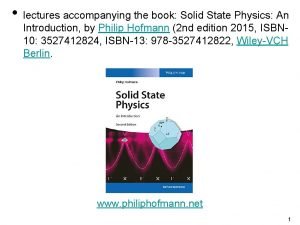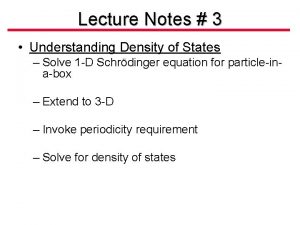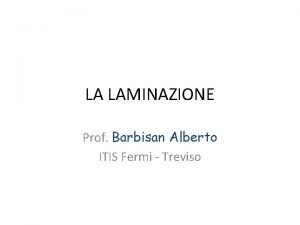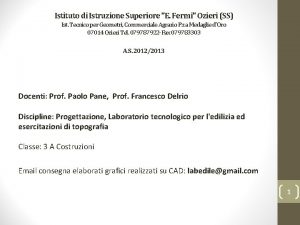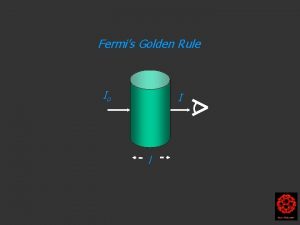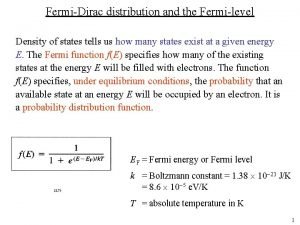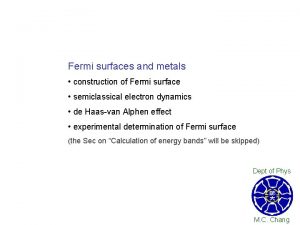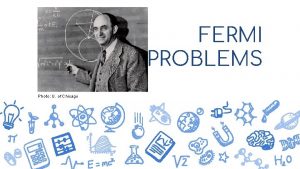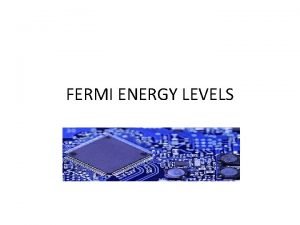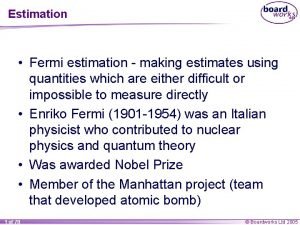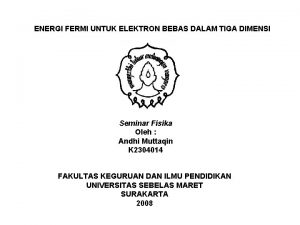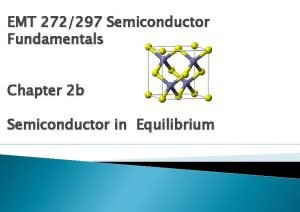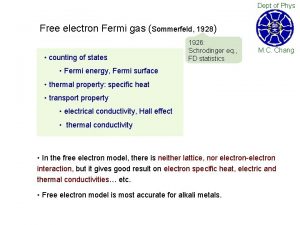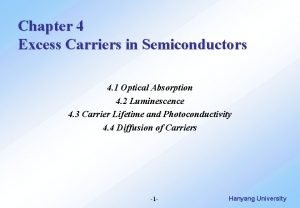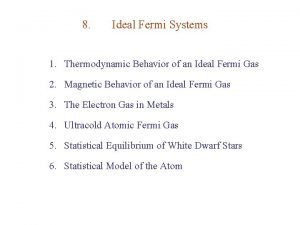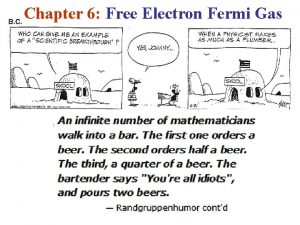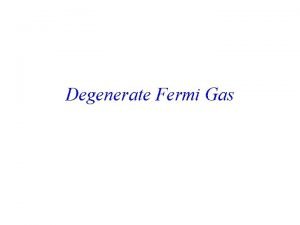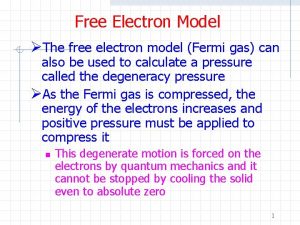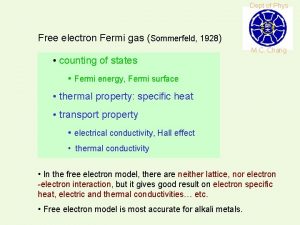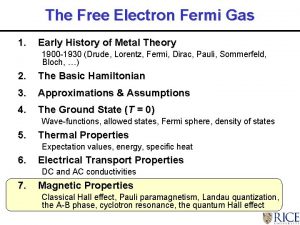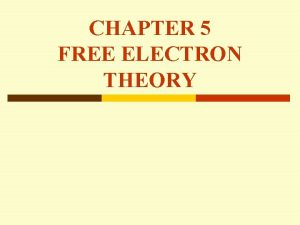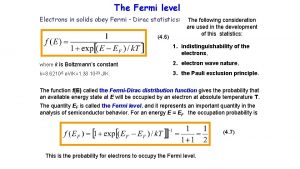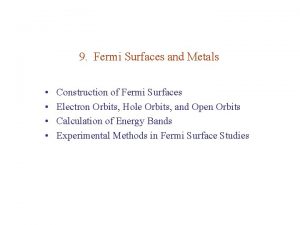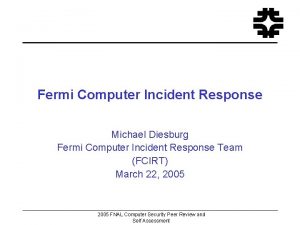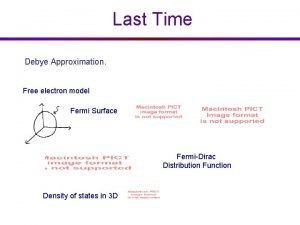Chapter 6 Free Electron Fermi Gas Free Electron



















































- Slides: 51

Chapter 6: Free Electron Fermi Gas

Free Electron Theory • Conductors fall into 2 main classes; metals & semiconductors. • Here, we focus on metals.

Free Electron Theory • Conductors fall into 2 main classes; metals & semiconductors. • Here, we focus on metals. • A metal is loosely defined as a solid with valence electrons that are not tightly bound to the atoms but are relatively easily able to move through the whole crystal.

• The room temperature resistivity of metals is in the range: • Experiments show that increases with the addition of small amounts of impurities. The resistivity normally decreases monotonically with decreasing temperature & it can be reduced by the addition of small amounts of impurity.

Question! • Why do mobile (conducting) electrons occur in some solids & not in others? • When the interactions between electrons are considered, this becomes a Very Difficult Question to Answer.

Some Common Properties of Metals: 1. 2. 3. 4. 5. Great Physical Strength High Density Good Electrical Conductivity Good Thermal Conductivity ……. etc. • In this chapter, we outline a surprisingly simple theory which does a very good job of explaining many of these common properties of metals. • In fact, theory is so simple (too simple to be realistic!) that we may wonder why it works so well!

“The Free Electron Model” • We begin with the assumption that conduction electrons exist & that they consist of the valence electrons from the metal atoms. • Thus, metallic Na, Mg & Al are assumed to have 1, 2 & 3 mobile electrons per atom, respectively. • This model seems at first as if it is Way Too Simple! • But, this simple model works remarkably well for many metals & it can be used to help to explain many properties of metals.

• According to this Free Electron Model (FEM), the valence electrons are responsible for the conduction of electricity, & for this reason these electrons are called “Conduction Electrons”. • As an example, consider Sodium (Na). The electron configuration of the Free Na Atom is: 2 2 s 2 2 p 6 3 s 1 1 s Core Electrons (tightly bound) Valence Electrons (loosely bound) • The outer electron in the third atomic shell (n = 3, ℓ = 0) is the electron which is responsible for the physical & chemical properties of Na.

Consider Fermions & Bosons in a 1 -D Potential Well

Consider Fermions & Bosons in a 1 -D Potential Well Note! Electrons are Fermions!!

• When Na atoms are put together to form a Na metal: Na metal Na has a BCC structure & the distance between nearest neighbors is 3. 7 A˚ • The radius of the third shell in Na iis 1. 9 A˚ • • In the solid, the electron wavefunctions of the Na atoms overlap slightly. From this observation it follows that a valence electron is no longer attached to a particular ion, but belongs to both neighboring ions at the same time.

• Therefore, these conduction electrons can be considered as moving independently in a square well of finite depth & the edges of the well correspond to the edges of the sample. • Consider a metal with a cubic shape with edge length L: Ψ & E can be found by solving the Schrödinger equation: 1 D version Since V • Use periodic boundary conditions & get Ψ’s as travelling plane waves. -L/2 0 L/2

• The solutions to the Schrödinger equation are plane waves, Normalization constant V = volume of the cube, V=L 3 • So the wave vector must be of the form: where p, q, r take any + or - integer values or zero.

• The wave function ψ(x, y, z) corresponds to the energy • The corresponding momentum is: • The energy is completely kinetic:

• We know that number of allowed k values in a spherical shell of k-space of radius k is: • g(k) is called the density of states per unit magnitude of k.

Number of Allowed States per Unit Energy Range? • Each k state represents two possible electron states, one for spin up, the other for spin down.

Ground State of the Free Electron Gas (T = 0) • Electrons are Fermions (s = ± ½) & obey the Pauli exclusion principle; each state can accommodate only one electron. • The lowest-energy state of N free electrons is therefore obtained by filling the N states of lowest energy.

• Thus all states are filled up to an energy EF, known as The Fermi energy, obtained by integrating the density of states between 0 and EF, The result should equal N. Remember that • Solving for EF (Fermi energy);

• The occupied states are inside the Fermi sphere in k-space as shown below; the radius is Fermi wave number k. F. kz From these two equations, Fermi Surface k. F can be found as, E = EF k. F ky kx • The surface of the Fermi sphere represents the boundary between occupied & unoccupied k states at T = 0 for the free electron gas.

• Typical values may be obtained by using monovalent potassium metal (K) as an example; for potassium, the atomic density & hence the valence electron density n = N/V = 1. 402 x 1028 m -3 so that • The Fermi (degeneracy) Temperature TF is given by

It is only at a temperature of this order that the particles in a classical gas can attain (gain) kinetic energies as high as EF. • Only at temperatures above TF will the free electron gas behave like a classical gas. • Fermi momentum • These are the momentum & velocity values of the electrons at the states on the Fermi surface of the Fermi sphere. So, the Fermi Sphere plays an important role in the behavior of metals.


Free Electron Gas at Non-Zero Temperature • From Statistical Mechanics, at a temperature T, the probability of occupation of an electron state of energy E is given by the Fermi distribution function • The Fermi distribution function f. FD(E) determines, at temperature T, the probability of finding an electron at energy E.

Fermi-Dirac Distribution & The Fermi-Level: Main Application: Electrons in a Conductor • The Density of States g(E) specifies how many states exist at a given energy E. • The Fermi Function f(E) specifies how many of the existing states at energy E will be filled with electrons. EF = Fermi Energy or Fermi Level k = Boltzmann Constant T = Absolute Temperature in K • The Fermi Function f(E) specifies, under equilibrium conditions, the probability that an available state at an energy E will be occupied by an electron. It is a probability distribution function. 24

Fermi-Dirac Statistics • The Fermi Energy EF is essentially the same as the Chemical Potential μ. β (1/k. T) EF is called The Fermi Energy. Note the following: • When E = EF, the exponential term = 1 & FFD = (½). • In the limit as T → 0: Ll • At T = 0, Fermions occupy the lowest energy levels. • Near T = 0, there is little chance that thermal agitation will kick a Fermion to an energy greater than EF.

Fermi-Dirac Distribution Consider T 0 K For E > EF : For E < EF : E A step function! EF 0 1 f(E)

Fermi Function at T = 0 & at a Finite Temperature f. FD=? At 0°K For E < EF f. FD(E, T) For E > EF 0. 5 E E<EF EF E>EF

Fermi-Dirac Distribution Temperature Dependence

Fermi-Dirac Distribution: T > 0 K FD Distribution l • If E = EF then f(EF) = ½. • If then: • So, the following approximation is valid: T • That is, most states at energies 3 k. T above EF are empty. 29

Fermi-Dirac Distribution: T > 0 K FD Distribution l • If then • So, the following approximation is valid: L • That is, most states at energies 3 k. T below EF are occupied. 30

Fermi-Dirac Distribution: Summary for T > 0 K FD Distribution l • So, the following is always true at room temperature: Only states within 3 k. T of EF will contribute to temperature dependent properties of the conduction electrons. k. T (at 300 K) = 0. 025 e. V, Eg(Si) = 1. 1 e. V, • So 3 k. T is very small in comparison to other energies relelevant to the electrons. 31

Fermi-Dirac Distribution Temperature Dependence T>0 T=0

The Fermi “Temperature” is defined as TF ≡ (EF)/(k. B). T=0 T>0 As the temperature increases from T = 0, The Fermi-Dirac Distribution “smears out”.

T = TF T >> TF • As the temperature increases from T = 0, The Fermi-Dirac Distribution “smears out”. • When T >> TF, FFD approaches a decaying exponential.

At T = 0 the Fermi Energy EF is the energy of the highest occupied energy level. • If there a total of N electrons, then is easy to show that EF has the form:

Fermi-Dirac Distribution Function

T-Dependence of the Chemical Potential Classical

Fermi Surface kz ky kx

Fermi-Dirac Distribution Function

Examples of Fermi Systems Electrons in metals (dense system)

• What is the number of electrons per unit energy range according to the free electron model? • This shows the change in distribution between absolute zero and a finite temperature. • n(E, T) = number of free electrons per unit energy range = area under n(E, T) graph.

• The FD distribution function is a symmetric function; at finite temperatures, the same number of levels below EF are emptied and same number of levels above EF are filled by electrons.

Equilibrium Distribution of Electrons • Distribution of Electrons at energy E = • Density of States Probability of • Occupancy g(E)f(E) • Total number of conduction electrons at energy E & temperature T: N E 0 g(E) f(E)d. E 43

Total Energy of a Gas of N Electrons Note: E Sorry!

• At T = 0, U = (3/5)NεF , this energy is large because all the electrons must occupy the lowest energy states up to the Fermi level. < > for a free electron in silver at T = 0: • The mean kinetic energy of an electron, even at T = 0, is 2 orders of magnitude greater than the mean kinetic energy of an ordinary gas molecule at room temperature.

Heat Capacity at Low T • The Total Energy at Temperature T: • The electronic heat capacity Ce can be found by taking the temperature derivative of U: • For temperatures T small compared with TF (true for any metal at room temperature), neglect the 2 nd term in the expansion & get

• For silver at room temperature: • So, the electronic specific heat = 2. 2 x 10 -2 R. This small value explains why metals have a specific heat capacity of about 3 R, the same as for other solids. • It was originally believed that their free electrons should contribute an additional (3/2) R associated with their three translational degrees of freedom. The calculation shows that this contribution is negligible. • The energy of the electrons changes only slightly with temperature (d. U/d. T is small) because only those electrons near the Fermi level can increase their energies as the temperature is raised, & there are very few of them.

• S = 0 at T = 0, as it must be. • The Helmholtz function F = U -TS is • The Fermion equation of state is:

• Silver: N/V = 5. 9 1028 m-3 so TF = 65, 000 K. • So, P = (2/5) (5. 9 1028)(1. 38 10 -23) (6. 5 104) = 2. 1 1010 Pa = 2. 1 105 atm = Pressure inside the electron gas! • Given this tremendous pressure, it is clear that the surface potential barrier needs to be huge in order to keep the electrons from evaporating from the metal.

Fermi energy for Aluminum assuming three electrons per Aluminum atom:

Low-Temperature Heat Capacity Copper
 Fermi velocity
Fermi velocity Free electron gas model
Free electron gas model Salient features of quantum free electron theory
Salient features of quantum free electron theory Degenerate fermi gas
Degenerate fermi gas Fermi gas
Fermi gas Unitary fermi gas
Unitary fermi gas Fermi gas model
Fermi gas model What is the noble gas notation
What is the noble gas notation Electron configuration vs noble gas configuration
Electron configuration vs noble gas configuration Electron configuration house
Electron configuration house Why are they called noble gases
Why are they called noble gases Gas electron multiplier
Gas electron multiplier Derive ideal gas equation
Derive ideal gas equation An ideal gas is an imaginary gas
An ideal gas is an imaginary gas Differences between ideal gas and real gas
Differences between ideal gas and real gas Ideal gas vs perfect gas
Ideal gas vs perfect gas Conclusion for bhopal gas tragedy
Conclusion for bhopal gas tragedy Gas leaked in bhopal gas tragedy
Gas leaked in bhopal gas tragedy Volume molare
Volume molare Flue gas desulfurisation gas filter
Flue gas desulfurisation gas filter Poisonous gas leaked in bhopal gas tragedy
Poisonous gas leaked in bhopal gas tragedy Difference between ideal gas and real gas
Difference between ideal gas and real gas Kinetika kimia
Kinetika kimia Gas exchange key events in gas exchange
Gas exchange key events in gas exchange Drude free electron theory
Drude free electron theory Nearly free electron theory
Nearly free electron theory Effective mass formula
Effective mass formula Success of classical free electron theory
Success of classical free electron theory Fermi estimates
Fermi estimates Energia de fermi
Energia de fermi Energia de fermi
Energia de fermi Fermi velocity
Fermi velocity Fermi velocity
Fermi velocity Intrinsic carrier concentration
Intrinsic carrier concentration Alberto barbisan
Alberto barbisan Istituto tecnico ozieri
Istituto tecnico ozieri Fermi bubbles
Fermi bubbles Rule.io
Rule.io 王騰漢
王騰漢 Fermilavel
Fermilavel Construction of fermi surface
Construction of fermi surface Fermi problem
Fermi problem Fermi-dirac distribution function at different temperatures
Fermi-dirac distribution function at different temperatures Fermi bubbles
Fermi bubbles Estimation de fermi
Estimation de fermi Elektron bebas
Elektron bebas Fermi energy formula
Fermi energy formula Fermi velocity
Fermi velocity Fermi golden rule
Fermi golden rule Excess carriers in semiconductors
Excess carriers in semiconductors Gpu architecture basics
Gpu architecture basics Zero point energy formula
Zero point energy formula
